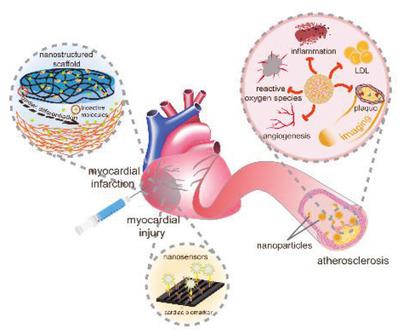当前位置:
X-MOL 学术
›
Adv. Healthcare Mater.
›
论文详情
Our official English website, www.x-mol.net, welcomes your feedback! (Note: you will need to create a separate account there.)
Nanomedicine Approaches for Advanced Diagnosis and Treatment of Atherosclerosis and Related Ischemic Diseases.
Advanced Healthcare Materials ( IF 10.0 ) Pub Date : 2020-06-29 , DOI: 10.1002/adhm.202000336 Bin Hu 1 , Kofi Oti Boakye-Yiadom 1 , Wei Yu 1 , Zi-Wei Yuan 1 , William Ho 2 , Xiaoyang Xu 2 , Xue-Qing Zhang 1
Advanced Healthcare Materials ( IF 10.0 ) Pub Date : 2020-06-29 , DOI: 10.1002/adhm.202000336 Bin Hu 1 , Kofi Oti Boakye-Yiadom 1 , Wei Yu 1 , Zi-Wei Yuan 1 , William Ho 2 , Xiaoyang Xu 2 , Xue-Qing Zhang 1
Affiliation

|
Cardiovascular diseases (CVDs) remain one of the major causes of mortality worldwide. In response to this and other worldwide health epidemics, nanomedicine has emerged as a rapidly evolving discipline that involves the development of innovative nanomaterials and nanotechnologies and their applications in therapy and diagnosis. Nanomedicine presents unique advantages over conventional medicines due to the superior properties intrinsic to nanoscopic therapies. Once used mainly for cancer therapies, recently, tremendous progress has been made in nanomedicine that has led to an overall improvement in the treatment and diagnosis of CVDs. This review elucidates the pathophysiology and potential targets of atherosclerosis and associated ischemic diseases. It may be fruitful to pursue future work in the nanomedicine‐mediated treatment of CVDs based on these targets. A comprehensive overview is then provided featuring the latest preclinical and clinical outcomes in cardiovascular imaging, biomarker detection, tissue engineering, and nanoscale delivery, with specific emphasis on nanoparticles, nanostructured scaffolds, and nanosensors. Finally, the challenges and opportunities regarding the future development and clinical translation of nanomedicine in related fields are discussed. Overall, this review aims to provide a deep and thorough understanding of the design, application, and future development of nanomedicine for atherosclerosis and related ischemic diseases.
中文翻译:

用于动脉粥样硬化和相关缺血性疾病的高级诊断和治疗的纳米医学方法。
心血管疾病(CVD)仍然是全球范围内导致死亡的主要原因之一。为了应对这种疾病以及全球范围内其他流行病的流行,纳米医学已经成为一门发展迅速的学科,涉及创新纳米材料和纳米技术的发展及其在治疗和诊断中的应用。纳米药物由于具有纳米疗法固有的优越性能,因此具有优于常规药物的独特优势。一旦主要用于癌症治疗,近来,纳米医学已取得了巨大的进步,从而导致了CVD的治疗和诊断的全面改善。这项审查阐明了动脉粥样硬化和相关的缺血性疾病的病理生理和潜在目标。基于这些目标,在纳米药物介导的CVD治疗方面开展进一步的工作可能会富有成果。然后提供了全面的概述,其中介绍了心血管成像,生物标志物检测,组织工程和纳米级递送方面的最新临床前和临床结果,尤其着重于纳米颗粒,纳米结构支架和纳米传感器。最后,讨论了纳米医学在相关领域的未来发展和临床翻译方面的挑战和机遇。总的来说,本综述旨在对用于动脉粥样硬化和相关缺血性疾病的纳米药物的设计,应用和未来发展提供深入而透彻的理解。生物标记物检测,组织工程和纳米级递送,尤其着重于纳米颗粒,纳米结构支架和纳米传感器。最后,讨论了纳米医学在相关领域的未来发展和临床翻译方面的挑战和机遇。总体而言,本综述旨在对用于动脉粥样硬化和相关缺血性疾病的纳米药物的设计,应用和未来发展提供深入而透彻的理解。生物标记物检测,组织工程和纳米级递送,尤其着重于纳米颗粒,纳米结构支架和纳米传感器。最后,讨论了纳米医学在相关领域的未来发展和临床翻译方面的挑战和机遇。总体而言,本综述旨在对用于动脉粥样硬化和相关缺血性疾病的纳米药物的设计,应用和未来发展提供深入而透彻的理解。
更新日期:2020-08-19
中文翻译:

用于动脉粥样硬化和相关缺血性疾病的高级诊断和治疗的纳米医学方法。
心血管疾病(CVD)仍然是全球范围内导致死亡的主要原因之一。为了应对这种疾病以及全球范围内其他流行病的流行,纳米医学已经成为一门发展迅速的学科,涉及创新纳米材料和纳米技术的发展及其在治疗和诊断中的应用。纳米药物由于具有纳米疗法固有的优越性能,因此具有优于常规药物的独特优势。一旦主要用于癌症治疗,近来,纳米医学已取得了巨大的进步,从而导致了CVD的治疗和诊断的全面改善。这项审查阐明了动脉粥样硬化和相关的缺血性疾病的病理生理和潜在目标。基于这些目标,在纳米药物介导的CVD治疗方面开展进一步的工作可能会富有成果。然后提供了全面的概述,其中介绍了心血管成像,生物标志物检测,组织工程和纳米级递送方面的最新临床前和临床结果,尤其着重于纳米颗粒,纳米结构支架和纳米传感器。最后,讨论了纳米医学在相关领域的未来发展和临床翻译方面的挑战和机遇。总的来说,本综述旨在对用于动脉粥样硬化和相关缺血性疾病的纳米药物的设计,应用和未来发展提供深入而透彻的理解。生物标记物检测,组织工程和纳米级递送,尤其着重于纳米颗粒,纳米结构支架和纳米传感器。最后,讨论了纳米医学在相关领域的未来发展和临床翻译方面的挑战和机遇。总体而言,本综述旨在对用于动脉粥样硬化和相关缺血性疾病的纳米药物的设计,应用和未来发展提供深入而透彻的理解。生物标记物检测,组织工程和纳米级递送,尤其着重于纳米颗粒,纳米结构支架和纳米传感器。最后,讨论了纳米医学在相关领域的未来发展和临床翻译方面的挑战和机遇。总体而言,本综述旨在对用于动脉粥样硬化和相关缺血性疾病的纳米药物的设计,应用和未来发展提供深入而透彻的理解。



























 京公网安备 11010802027423号
京公网安备 11010802027423号